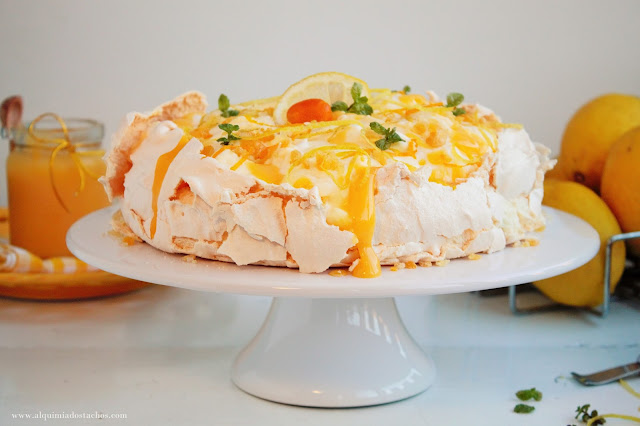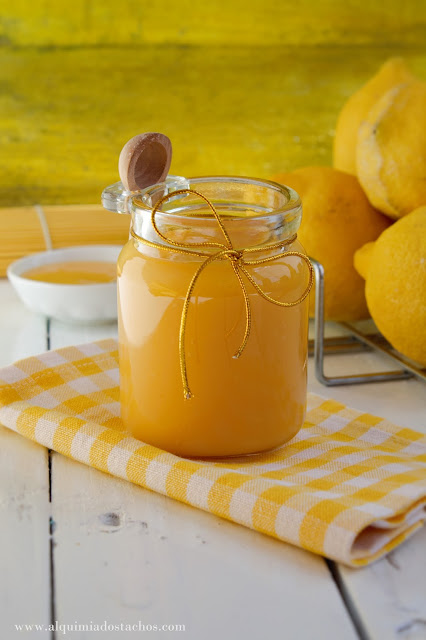Sei que prometi um bolo para comemorar o 5º aniversário do blog… Mas em vez disso saiu uma pavlova 🙂
Isto aconteceu porque a Pavlova é muito provavelmente a minha sobremesa favorita. E os citrinos são também a minha predilecção.
A combinação destes dois só podia resultar numa combinação deliciosa!
Ingredientes:
- 4 claras de ovo (140 gramas)
- 200 gramas de açúcar em pó
- 1/2 colher de chá de extracto de baunilha
- 1 colher de chá de vinagre branco
- 1/2 colher de sopa de amido de milho (farinha tipo maisena)
cobertura:
- 200 ml de natas frescas para bater
- 100 ml de curd de limão
- zestes (raspas) de limão
- 6 kumquat cristalizados (picados – opcional)
Preparação:
Pré aqueça o forno a 130ºC.
Forre um tabuleiro com papel manteiga (papel vegetal) e desenhe um círculo de 18 cm no papel. Vire o papel, de modo que o círculo fique no lado inverso.
Para fazer a Pavlova primeiro bata as claras até formar picos moles. Em seguida, adicione o açúcar, uma colher de sopa de cada vez, e continue a bater até o merengue formar picos duros e brilhantes.
Junte o extracto de baunilha. Com uma espátula de borracha, envolver delicadamente o amido de milho e o vinagre. (Adicionando estes dois ingredientes vai dar à Pavlova uma crosta tostadinha)
Coza durante 60 a 75 minutos ou até o exterior estar seco e com uma cor creme pálida. Desligue o forno, deixe a porta entreaberta, e deixe o merengue esfriar completamente dentro do forno. (A parte externa do merengue vai-se sentir firme ao toque, se suavemente pressionado. O interior fica macio, semelhante a marshmallowy.)
Nota: O merengue depois de frio pode ser armazenado em local fresco e seco, num recipiente hermético, por alguns dias.
Cobertura:
Bata as natas até obter picos firmes e suavemente (sem bater) envolva-lhe o curd de limão. Cubra a pavlova com este creme e decore a gosto.
Sugestão: Colheradas de curd de limão, zestes/raspas de limão e kumquat (cristalizados) picados.
Curd de Limão
Ingredientes:
- 3 ovos grandes
- 150 gramas açúcar
- 80 ml de sumo de limão (2-3 limões)
- 60 g de manteiga sem sal (temperatura ambiente)
- 1 colher de raspas de limão finamente picado
Preparação:
Numa bacia de inox colocada sobre uma panela de água a ferver (benho-maria) misture os ovos, o açúcar e sumo de limão até tudo estar envolvido. Cozinhe, mexendo sempre (para evitar que coalhe) até que a mistura se torne espessa. Este processo levará aproximadamente 10 minutos. Retire do lume e coe para remover todas as protuberâncias. Corte a manteiga em pedaços pequenos e envolva-os na mistura até que a esta derreta. Adicione as raspas de limão e deixe arrefecer. O curd de limão continuará a engrossar enquanto arrefece. Cubra imediatamente (assim evita que se forme uma pele) e leve ao frigorífico até arrefecer completamente. Dura até uma semana.
Pavlova Recipe
- 4 large (120 grams) egg whites
- 1 cup (200 grams) superfine or castor sugar
- 1/2 teaspoon pure vanilla extract
- 1 teaspoon white vinegar
- 1/2 tablespoon cornstarch (corn flour)
Preheat oven to 250 degrees F (130 degrees C) and place rack in center of oven. Line a baking sheet with parchment paper and draw a 7 inch (18 cm) circle on the paper. Turn the parchment paper over so the circle is on the reverse side.
In the bowl of your electric mixer, with the whisk attachment, beat the egg whites on medium speed until they hold soft peaks. Start adding the sugar, a tablespoon at a time, and continue to beat, on high speed, until the meringue holds very stiff and shiny peaks. (Test to see if the sugar is fully dissolved by rubbing a little of the meringue between your thumb and index finger. The meringue should feel smooth, not gritty. If it feels gritty the sugar has not fully dissolved so keep beating until it feels smooth between your fingers). Beat in the vanilla extract. Sprinkle the vinegar and cornstarch over the top of the meringue and, with a rubber spatula, gently fold in. Spread the meringue inside the circle drawn on the parchment paper, smoothing the edges.
Bake for 60 to 75 minutes or until the outside is dry and a very pale cream color. Turn the oven off, leave the door slightly ajar, and let the meringue cool completely in the oven. (The outside of the meringue will feel firm to the touch, if gently pressed, but as it cools you will get a little cracking and you will see that the inside is soft and marshmallowy.)
The cooled meringue can be made and stored in a cool dry place, in an airtight container, for a few days.
Lemon Curd Recipe:
- 3 large eggs
- 3/4 cup (150 grams) granulated white sugar
- 1/3 cup (80 ml) fresh lemon juice (2-3 lemons)
- 4 tablespoons (60 grams) unsalted butter, at room temperature
- 1 tablespoon (4 grams) finely shredded lemon zest
In a stainless steel bowl placed over a saucepan of simmering water, whisk together the eggs, sugar, and lemon juice until blended. Cook, stirring constantly (to prevent it from curdling), until the mixture becomes thick. This will take approximately 10 minutes. Remove from heat and immediately pour through a fine strainer to remove any lumps. Cut the butter into small pieces and whisk into the mixture until the butter has melted. Add the lemon zest and let cool. The lemon curd will continue to thicken as it cools. Cover immediately (so a skin doesn’t form) and refrigerate for up to a week.





Essa pavlova está soberba!
Obrigada 😉
Adorei… Este blog está a ser a minha perdição… Agora é que vou ficar redonda….
Muitos Parabéns
Obrigada, Paula.
Nada que um bocadinho de exercício não cure 🙂
Deve ser uma delícia esta pavlova! Ai se eu apanhava aqui uma fatia à minha frente 🙂 Parabéns!
Obrigada, Sílvia 😉
Adoro esta combinação, da pavlova com o lemnon curd! Já a fiz várias vezes e não falha, desaparece em minutos 😉 Pode não ser um bolo, mas para festejar ele não é obrigatório; e esta pavlova está à altura!
Parabéns pelo 5º!
Teresa | A Cozinha da Ovelha Negra
Obrigada, Teresa. 😉
Beijinho e boa semana!
Que linda pavlova! E com lemon curd fica um mimo! 🙂
Parabéns pelo 5º aniversário!
Beijinhos
Ana Filipa Costa || Petiscana
Obrigada, Ana Filipa.
Beijinhos e boa semana!
Também adoro pavlova! Com citrinos nunca fiz, mas deve ficar uma delícia! A julgar pelo aspeto dessa… 😉
Parabéns novamente 😀